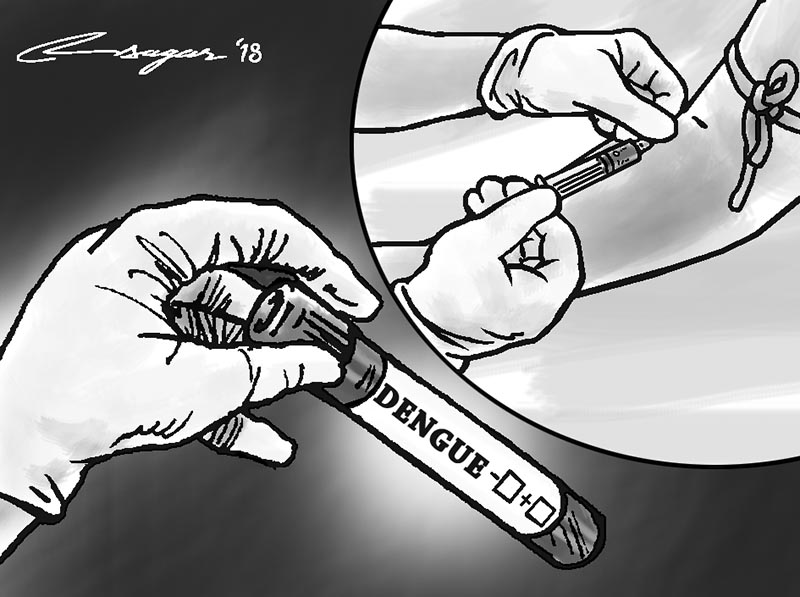Fighting dengue: More efforts required
There are four dengue virus serotypes, and all four serotypes are now well established in Nepal. The concerned authority hence must consider disseminating information about serotypes of dengue virus circulating in real-time in every season
During October through December, if a person live in or visit dengue endemic area and develops sudden onset of high-grade fever accompanied by pain behind the eyes, severe headache, joint pain, muscular pain, red eyes, nausea/vomiting, and pinpoint red rash over the body, then it could be a dengue case. Dengue is comparatively a new mosquito-transmitted viral disease in Nepal. Its activity usually starts in October and peaks through November and December. In early October, half a dozen patients from Balaju, Kathmandu and two from Pokhara, Kaski were found to be contracted dengue virus. This was the first known outbreak of dengue virus in Nepal this year (2018). Since then, febrile patients due to dengue virus have been reported across the country, indicating that dengue season had arrived in Nepal.
Dengue becomes symptomatic 4 to 10 days after infection. Interestingly, a few days ago, a boy who was laboratory tested positive for dengue virus showed no signs and symptoms compatible to this virus. A laboratory confirmation, therefore, is a must, if a patient with low-grade fever is seen during dengue season and is from or has visited the area where Aedesaegypty mosquitoes are abundant. Currently, laboratory testing for dengue virus is available at the Sukraraj Tropical and Infectious Disease Hospital and National Public Health Laboratory, Kathmandu. There are also private laboratories/hospitals where dengue testing is available.
At present, the government is focusing on “mosquito search and destroy programme” where dengue outbreak has occurred. Nevertheless, there is a need to revise this “mosquito search and destroy programme periodically in order to identify emerging challenges. Such measures should be based on geographical locations as problems may vary in different regions (Tarai, Hilly and Himalayan regions).
Destroying mosquitoes after an outbreak is neither possible nor an effective way to deal with the challenges. The government hence first must identify dengue season and implement preventive measures in place before an outbreak. Health care workers are also at risk of dengue virus infection at hospitals while treating patients infected with dengue virus. It would be, thus, wise to treat a patient under mosquito net because a mosquito which carries dengue virus is a day biter and can transmit dengue virus to health care providers.
Imported dengue is becoming one of the main public health challenges or even threats in Nepal. A few days ago, some people, who have been residing in India and Malaysia, visited the outpatient department of Sukraraj Tropical & Infectious Disease Hospital to receive counselling and/ or treatment after they were diagnosed with dengue in respective countries.
According to them, dozens of other Nepali living in those countries are also suffering from dengue fever and are being treated at local hospitals.
If an Aedes mosquito bites an ill patient during febrile viremic phase (while virus circulating in the blood), that mosquito may become infected and can subsequently transmit the virus to a healthy person. In another words, if an ill person arrives in Nepal following a virus infection and bitten by a local mosquito, it can potentially spread dengue virus to other people, which subsequently result in an outbreak.
We therefore should pay attention to this issue and need a separate health education programme/counselling to those who are leaving abroad where dengue virus is endemic.
Knowing serotypes of dengue virus can help health care providers to predict the severity of the disease. If a person is infected second time with a different serotype of dengue virus, there is a high chance of developing severe dengue known as “dengue haemorrhagic fever” and “dengue shock syndrome”.
The dengue virus consists of four serotypes known as DENV-1, DENV-2, DENV-3 and DENV-4, and all four serotypes are now well established in Nepal. The concerned authority, thus, must consider disseminating information about serotypes of dengue virus circulating in real-time in every season so that health care providers can predict the disease outcomes.
It is even more useful for those who are working in remote areas where dengue virus epidemic occurs almost every year. This year, some dengue patients, who were residents of Kathmandu, also presented with acute gum bleeding and petechial rash (leaking blood into the skin), which are considered to be sings of “dengue haemorrhagic fever”. However, side-by-side laboratory testings are critical to establish disease severity, monitor disease progress and estimate treatment plan.
The onset of outbreak of dengue virus is dangerous but almost unpredictable.
The first major dengue outbreak occurred in Butwal, Rupandehi in 2010, followed by Lalbandi, Sarlahi in 2017 and now in Pokhara, although dengue patients have been reporting in large numbers from other places such as Chitwan, Jhapa and Parsa annually. It is for sure that dengue outbreak can occurs anywhere during dengue season (October through December), where Aedes mosquitoes are abundant. Nationwide baseline, but comprehensive, vector surveillance, therefore, is a must.
Pun is chief of clinical research unit at Sukraraj Tropical & Infectious Disease Hospital






